《管理学》课程教学资源(课件讲义)Stephen P.Robbins(9)Chapter 2 Management Yesterday and Today
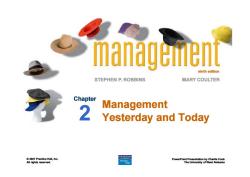
management ninth edition STEPHEN P.ROBBINS MARY COULTER Chapter Management 2 Yesterday and Today PEARSON
ninth edition STEPHEN P. ROBBINS STEPHEN P. ROBBINS MARY COULTER MARY COULTER Management Chapter 2 g Yesterday and Today PowerPoint Presentation by Charlie Cook The University of West Alabama © 2007 Prentice Hall, Inc. All rights reserved
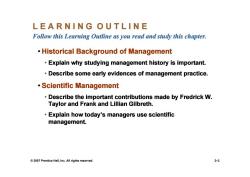
LEARNING OUTLINE Follow this Learning Outline as you read and study this chapter. Historical Background of Management Explain why studying management history is important. Describe some early evidences of management practice. Scientific Management Describe the important contributions made by Fredrick W. Taylor and Frank and Lillian Gilbreth. Explain how today's managers use scientific management. 2007 Prentice Hall,Inc.All rights reserved. 2-2
LEARNING OUTLINE L E A R N I N G O U T L I N E Follow this Learning Outline as you read and study this chapter. • Historical Background of Management • Explain why studying management history is important. • Describe some early evidences of management practice. • Scientific Mana gement • Describe the important contributions made by Fredrick W. Taylor and Frank and Lillian Gilbreth. • Explain how today’s managers use scientific management. © 2007 Prentice Hall, Inc. All rights reserved. 2–2
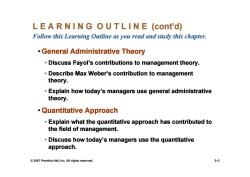
LEARNING OUTLINE (cont'd) Follow this Learning Outline as you read and study this chapter. General Administrative Theory Discuss Fayol's contributions to management theory. Describe Max Weber's contribution to management theory. Explain how today's managers use general administrative theory. Quantitative Approach Explain what the quantitative approach has contributed to the field of management. Discuss how today's managers use the quantitative approach. 2007 Prentice Hall,Inc.All rights reserved. 2-3
L E A R N I N G O U T L I N E (cont L E A R N I N G O U T L I N E (cont d) (cont d) ’ Follow this Learning Outline as you read and study this chapter. • General Administrative Theory • Discuss Fayol’s contributions to management theory. • Describe Max Weber’s contribution to management theory. • Explain how today’s managers use general administrative theory. • Q tit ti A h Quantit ative Approac h • Explain what the quantitative approach has contributed to the field of management the field of management management. • Discuss how today’s managers use the quantitative approach. © 2007 Prentice Hall, Inc. All rights reserved. 2–3
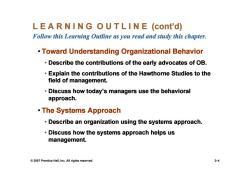
LEARNING OUTLINE (cont'd) Follow this Learning Outline as you read and study this chapter. Toward Understanding Organizational Behavior Describe the contributions of the early advocates of OB. Explain the contributions of the Hawthorne Studies to the field of management. Discuss how today's managers use the behavioral approach. ·The Systems Approach Describe an organization using the systems approach. Discuss how the systems approach helps us management. 2007 Prentice Hall,Inc.All rights reserved. 2-4
L E A R N I N G O U T L I N E (cont L E A R N I N G O U T L I N E (cont d) (cont d) ’ Follow this Learning Outline as you read and study this chapter. • Toward Understanding Organizational Behavior • Describe the contributions of the early advocates of OB. • Explain the contributions of the Hawthorne Studies to the field of management. • Discuss how today’s managers use the behavioral approach. • Th S t A h The Sys tems Approac h • Describe an organization using the systems approach. • Discuss how the systems approach helps us management. © 2007 Prentice Hall, Inc. All rights reserved. 2–4
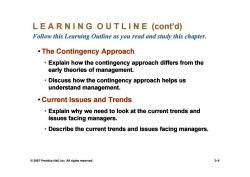
LEARNING OUTLINE (cont'd) Follow this Learning Outline as you read and study this chapter. The Contingency Approach Explain how the contingency approach differs from the early theories of management. Discuss how the contingency approach helps us understand management. Current Issues and Trends Explain why we need to look at the current trends and issues facing managers. Describe the current trends and issues facing managers. 2007 Prentice Hall,Inc.All rights reserved. 2-5
L E A R N I N G O U T L I N E (cont L E A R N I N G O U T L I N E (cont d) (cont d) ’ Follow this Learning Outline as you read and study this chapter. • The Contingency Approach • Explain how the contingency approach differs from the earl th i f t ly theories o f managemen managemen t. • Discuss how the contingency approach helps us understand management understand management. • Current Issues and Trends • Explain why we need to look at the current trends and issues facing managers. • Describe the current trends and issues facing managers Describe Describe the current current trends and issues facing managers managers. © 2007 Prentice Hall, Inc. All rights reserved. 2–5
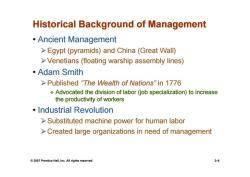
Historical Background of Management ·Ancient Management >Egypt(pyramids)and China(Great Wall) >Venetians(floating warship assembly lines) ·Adam Smith >Published "The Wealth of Nations"in 1776 Advocated the division of labor (job specialization)to increase the productivity of workers Industrial Revolution >Substituted machine power for human labor >Created large organizations in need of management 2007 Prentice Hall,Inc.All rights reserved. 2-6
Historical Backg g round of Management • Ancient Management ¾E t ( id ) d Chi (G t W ll) Egypt (pyramids) and China (Great Wall) ¾Venetians (floating warship assembly lines) • Adam Smith ¾Published “The Wealth of Nations” in 1776 Advocated the division of labor (job specialization) to increase the productivity of workers • Industrial Revolution Industrial Revolution ¾Substituted machine power for human labor ¾C dl i i i d f Created large organ arge organizations in need of management management © 2007 Prentice Hall, Inc. All rights reserved. 2–6

Exhibit 2-1 Development of Major Management Theories Management Theories Historical Scientific Quantitative Organizational Systems Contingency Background Management Theorists Approach Behavior Approach Approach Early Examples Early of Management Ad小vocates Adam Smith _Hawthorne Studles Industrial Revolution 2007 Prentice Hall,Inc.All rights reserved. 2-7
Exhibit 2 Exhibit 2–1 Develop jg ment of Ma ment of Major Mana or Management Theories ement Theories © 2007 Prentice Hall, Inc. All rights reserved. 2–7
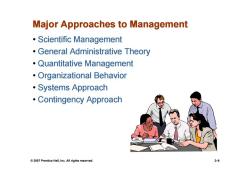
Major Approaches to Management Scientific Management General Administrative Theory Quantitative Management Organizational Behavior ·Systems Approach Contingency Approach 2007 Prentice Hall,Inc.All rights reserved. 2-8
Maj pp g or Approaches to Mana roaches to Management • Scientific Management • General Administrative Theory • Quantitative Management • Organizational Behavior • Systems Approach Systems Approach • Contingency Approach © 2007 Prentice Hall, Inc. All rights reserved. 2–8
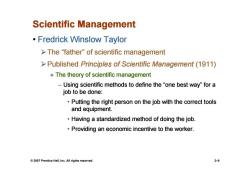
Scientific Management Fredrick Winslow Taylor >The“father'”of scientific management >Published Principles of Scientific Management (1911) The theory of scientific management -Using scientific methods to define the "one best way"for a job to be done: Putting the right person on the job with the correct tools and equipment. Having a standardized method of doing the job. Providing an economic incentive to the worker. 2007 Prentice Hall,Inc.All rights reserved. 2-9
Scientific Management • Fredrick Winslow Taylor ¾The “father” of scientific management ¾Published Principles of Scientific Management (1911) The theory of scientific management – Using scientific methods to define the “one best way” for a job to be done: • Putting the right person on the job with the correct tools and equipment and equipment. • Having a standardized method of doing the job. • Providing an economic incentive to the worker Providing Providing an economic economic incentive incentive to the worker. © 2007 Prentice Hall, Inc. All rights reserved. 2–9
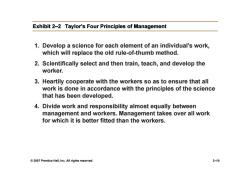
Exhibit 2-2 Taylor's Four Principles of Management 1.Develop a science for each element of an individual's work, which will replace the old rule-of-thumb method. 2.Scientifically select and then train,teach,and develop the worker. 3.Heartily cooperate with the workers so as to ensure that all work is done in accordance with the principles of the science that has been developed. 4.Divide work and responsibility almost equally between management and workers.Management takes over all work for which it is better fitted than the workers. 2007 Prentice Hall,Inc.All rights reserved. 2-10
Exhibit 2 Exhibit 2–2 Tay pg lor’s Four Princi lor’s Four Principles of Mana les of Management 1. Develop , a science for each element of an individual’s work, which will replace the old rule-of-thumb method. 2. Scientifically select and then train, teach, and develop the worker. 3. Heartily cooperate with the workers so as to ensure that all work is done in accordance with the principles of the science work is done in accordance with the principles of the science that has been developed. 4. Divide work and resp y qy onsibility almost equally between management and workers. Management takes over all work for which it is better fitted than the workers. © 2007 Prentice Hall, Inc. All rights reserved. 2–10
按次数下载不扣除下载券;
注册用户24小时内重复下载只扣除一次;
顺序:VIP每日次数-->可用次数-->下载券;
- 《管理学》课程教学资源(课件讲义)Stephen P.Robbins(9)Chapter 1 Introduction to Management and Organizations.pdf
- 《管理学》课程教学资源(教师手册)Stephen P.Robbins(9)CHAPTER TWO Management Yesterday.pdf
- 《管理学》课程教学资源(教师手册)Stephen P.Robbins(9)CHAPTER ONE Introduction to Management.pdf
- 《管理学》课程PPT教学课件(Management)Stephen P.Robbins(9)第十二章 人力资源管理 Human Resource Management.ppt
- 《管理学》课程PPT教学课件(Management)Stephen P.Robbins(9)第十章 组织结构与设计 Organizational Structure and Design.ppt
- 《管理学》课程PPT教学课件(Management)Stephen P.Robbins(9)第十五章 理解群体与团队 Understanding Groups and Teams.ppt
- 《管理学》课程PPT教学课件(Management)Stephen P.Robbins(9)第十九章 运营及价值链管理 Operations and Value Chain Management.ppt
- 《管理学》课程PPT教学课件(Management)Stephen P.Robbins(9)第三章 组织文化与环境——约束力量 Organizational Culture and Environment - The Constraints.ppt
- 《管理学》课程PPT教学课件(Management)Stephen P.Robbins(9)第二章 管理的昨天和今天 Management Yesterday and Today.ppt
- 《管理学》课程PPT教学课件(Management)Stephen P.Robbins(9)第五章 社会责任与道德管理 Social Responsibility and Managerial Ethics.ppt
- 《管理学》课程PPT教学课件(Management)Stephen P.Robbins(9)第四章 全球环境中的管理 Managing in a Global Environment.ppt
- 《管理学》课程PPT教学课件(Management)Stephen P.Robbins(9)第六章 制定决策——管理者工作的实质 Decision-Making - The Essence of the Manager’s Job.ppt
- 《管理学》课程PPT教学课件(Management)Stephen P.Robbins(9)第八章 战略管理 Strategic Management.ppt
- 《管理学》课程PPT教学课件(Management)Stephen P.Robbins(9)第十六章 激励员工 Motivating Employees.ppt
- 《管理学》课程PPT教学课件(Management)Stephen P.Robbins(9)第十一章 管理沟通与信息技术 Communication and Information Technology.ppt
- 《管理学》课程PPT教学课件(Management)Stephen P.Robbins(9)第一章 管理与组织导论 Introduction to Management and Organizations.ppt
- 《管理学》课程PPT教学课件(Management)Stephen P.Robbins(9)第七章 计划的基础 Foundations of Planning.ppt
- 新疆大学:《管理学》课程教学课件(PPT讲稿)第十五章 控制方法.ppt
- 新疆大学:《管理学》课程教学课件(PPT讲稿)第十四章 控制与控制过程.ppt
- 新疆大学:《管理学》课程教学课件(PPT讲稿)第四篇 领导 第十二章 激励.ppt
- 《管理学》课程PPT教学课件(Management, 7th Edition)Chapter 06 DECISION MAKING:THE ESSENCE OF THE MANAGER’S JOB.ppt
- 《管理学》课程PPT教学课件(Management, 7th Edition)Chapter 07 FOUNDATIONS OF PLANNING.ppt
- 《管理学》课程PPT教学课件(Management, 7th Edition)Chapter 08 STRATEGIC MANAGEMENT.ppt
- 《管理学》课程PPT教学课件(Management, 7th Edition)Chapter 09 PLANNING TOOLS AND TECHNIQUES.ppt
- 《管理学》课程PPT教学课件(Management, 7th Edition)Chapter 10 ORGANIZATIONAL STRUCTURE AND DESIGN.ppt
- 《管理学》课程PPT教学课件(Management, 7th Edition)Chapter 11 MANAGERIAL COMMUNICATION AND INFORMATION TECHNOLOGY.ppt
- 《管理学》课程PPT教学课件(Management, 7th Edition)Chapter 12 HUMAN RESOURCE MANAGEMENT(HRM).ppt
- 《管理学》课程PPT教学课件(Management, 7th Edition)Chapter 13 MANAGING CHANGE AND INNOVATION.ppt
- 《管理学》课程PPT教学课件(Management, 7th Edition)Chapter 14 FOUNDATIONS OF BEHAVIOR.ppt
- 《管理学》课程PPT教学课件(Management, 7th Edition)Chapter 15 UNDERSTANDING GROUPS AND TEAMS.ppt
- 《管理学》课程PPT教学课件(Management, 7th Edition)Chapter 16 MOTIVATING EMPLOYEES.ppt
- 《管理学》课程PPT教学课件(Management, 7th Edition)Chapter 18 FOUNDATIONS OF CONTROL.ppt
- 《管理学》课程PPT教学课件(Management, 7th Edition)Chapter 19 OPERATIONS AND VALUE CHAIN MANAGEMENT.ppt
- 《管理学》课程PPT教学课件(Management, 7th Edition)Chapter 20 CONTROLLING FOR ORGANIZATIONAL PERFORMANCE.ppt
- 《管理学》课程教学资源(实验讲义)企业竞争模拟攻略篇.pdf
- 《管理学》课程教学资源(习题与答案)第1章 管理活动与管理理论.doc
- 《管理学》课程教学资源(习题与答案)第3章 全球化与管理.doc
- 《管理学》课程教学资源(习题与答案)第6章 计划与计划工作.doc
- 《管理学》课程教学资源(习题与答案)第十章 组织变革与组织文化.doc
- 《管理学》课程教学资源(习题与答案)第16章 管理的创新职能.doc
